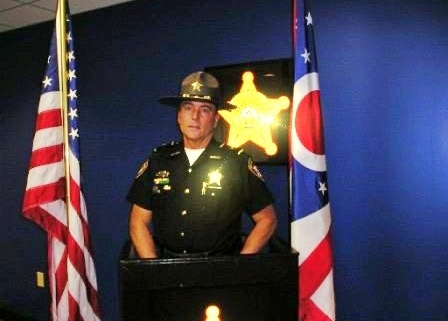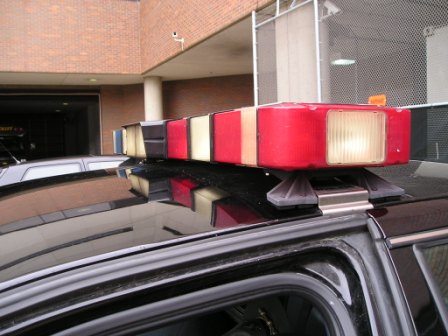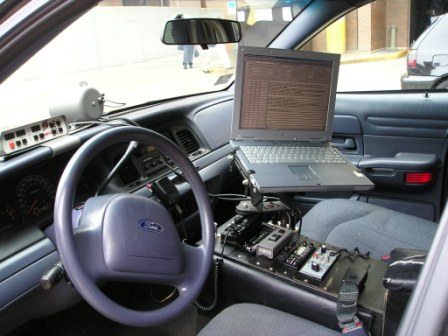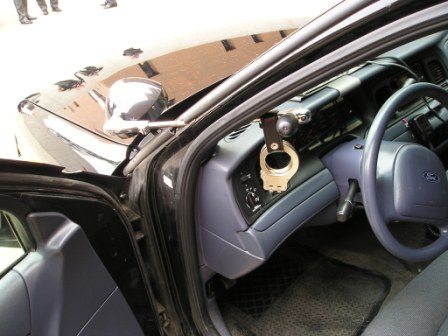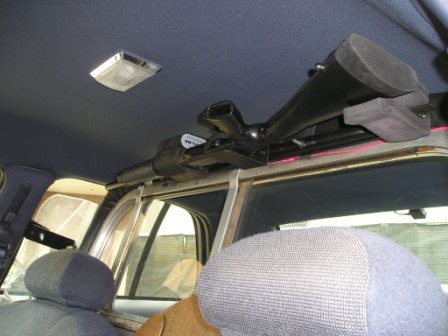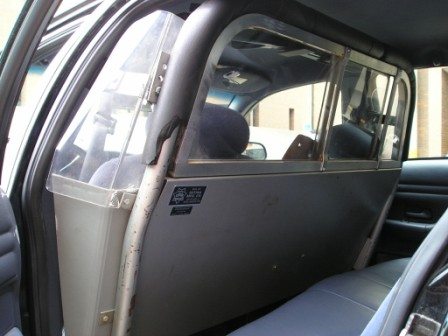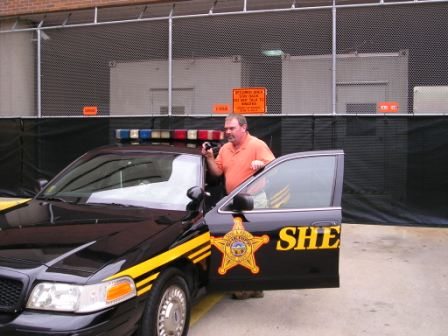Many of us had our first real look at a sheriff’s office back in 1960 when Andy Taylor and his fearless deputy, Barney Fife, patrolled the roads in and around Mayberry, N.C.
Television took us inside the Mayberry jail, the courthouse, and it even allowed us to ride in the county patrol car. And, for many people, Andy Taylor’s Sheriff’s Office was the standard. The things Andy did, well, that’s what a sheriff was supposed to do—fight crime, run the jail, serve the people of the community, spending quality and quiet time on his front porch with Aunt Bee, Barney, Opie and Miss Ellie and later, Helen, and pickin’ and grinnin’ with the Darlings.
But that’s the TV depiction of the life of a county sheriff. Real sheriffin’, however, is a bit different. So let’s take a brief look at a real-life, modern day sheriff and her/his office to see how things differ from the fictional Mayberry department.
First, like Andy, a sheriff is only one person, an elected official who’s in charge of a of the day-to-day operations of their office. And, since they have many responsibilities they’ll need help to fulfill their duties. Therefore, deputies are appointed (not hired) by the sheriff, to help with the workload. For example, the Clark County, Ohio sheriff’s office is comprised of the Sheriff (former sheriff Gene Kelly – pictured above). At the time Sheriff Kelly was in office, his staff consisted of one Chief Deputy, one Major, four Lieutenants, seventeen Sergeants, one-hundred-nine Deputies and thirty-four civilian support staff.
The current sheriff of Clark County, Ohio is Deborah K. Burchett.
Sheriff Burkett’s staff is comprised of the following:
- Sheriff Burchett
- Chief deputy
- 3 Majors
- 4 Lieutenants
- 16 Sergeants
- 117 Deputies
- 50 Civilian support staff
- Jail administrator
Sheriff Burchett and her command staff oversee the following divisions within her office.
- Administrative
- Civil
- Criminal Investigations
- Jail / Court Services
- Uniform Patrol
- Professional Standards
*Each person who wears or carries a badge within a sheriff’s office is a deputy sheriff. Not all, though, are law enforcement officers. More on this later.
Deputy Sheriffs
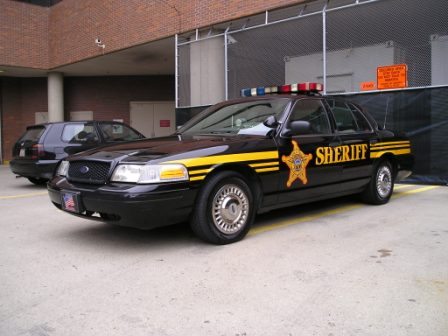
When a sheriff’s car is seen rolling along the highways and streets, many people assume the driver is a cop just like any other cop—a patrol officer who wears a gun and answers calls doled out by a 911 dispatcher.
Well, that’s partly true. They do answer calls. BUT, a deputy’s job is far more than just arresting people and putting them in jail. First of all, the drivers of those marked “sheriff’s” cars are typically deputy sheriffs, not the actual sheriff. Unless, of course, the sheriff happens to be driving one. Many sheriffs, though, opt for unmarked vehicles.
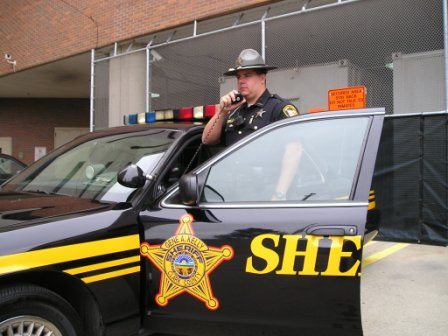
Pictured above is a deputy sheriff and his patrol car.
Okay, we know that sheriff’s are in charge of the county jails and for patrolling county roadways and responding to criminal complaints. And we’re well aware that they serve civil process, such as jury summons, lien notices, foreclosures, and evictions. We also know that a sheriff assigns deputies to protect the courts, judges, and to supervise prisoners. But did you know that the duties of sheriffs and deputies may also include:
- K-9 handlers
- evicting people from homes and businesses per court orders
- transporting prisoners
- serving on local, state, and federal task forces
- search and rescue
- teaching at police academies and schools
- undercover assignments
- sting operations
- traffic enforcement
- cold cases
- mobile crime labs
- In California, some sheriffs also serve as coroner of their counties.
- Corrections officers in the county jail
and much, much more.
In the top photo, for example, Sheriff Kelly is presiding over a sheriff’s sale. A sheriff’s sale is basically an auction to dispose of/liquidate property in which a mortgage owner has defaulted.
In many areas, since some towns do not have police departments, the sheriff is responsible for all law enforcement of their jurisdiction. This is so, even in areas with their own police departments. This includes all towns and cities and villages within a county whose citizens voted to elect the sheriff.
All jurisdictions (with the exception of Alaska, Hawaii, and Connecticut) must have a sheriff’s office.
Per state law, Sheriffs in the state of Delaware do not have police powers!
Delaware is small state with only three counties. Each county—Sussex, New Castle, and Kent—has a county sheriff. However, as you’ll read below from Title 10 of the Delaware Code, sheriffs and their deputies do not have police powers, including the power to arrest.
§ 2103 Sheriffs and regular deputies.
Sheriffs and deputy sheriffs shall not have any arrest authority. However, sheriffs and deputy sheriffs may take into custody and transport a person when specifically so ordered by a judge or commissioner of Superior Court.
In Delaware the duties of the county sheriffs and their deputies is:
Sussex County – Serve paper for the courts and holds Sheriff’s sales for non-payment of taxes, mortgage foreclosures plus all other court orders.
New Castle County – Provides service of process for writs issued by the Superior Court, Court of Common Pleas, Court of Chancery, Family Court and courts from other states and countries along with subpoenas issued by the Department of Justice, Department of Labor, and Industrial Accident Board.
Kent County – Service the Citizens of Kent County by performing many functions for the State of Delaware Courts (Superior Court, Court of Common Pleas, U.S. District Court and the Court of Chancery). The Sheriff’s Office serves legal notices to include (subpoenas, levies, summons, etc.) Additionally, the Sheriff’s Office auctions real estate in accordance with the Delaware Code.
A deputy’s patrol car
The light bar on the vehicle’s top features white takedown lights (front), and side alley lights. These lights are merely white spotlights that’re used to illuminate specific items, or people, during traffic stops and other situations. The bar is also equipped with red and/or blue emergency lights. Some light bars are equipped with speakers for the siren (most siren horns are mounted in the front grill). Other light bars contain hidden radar antennas. The positioning and style of light bars depend on the individual department policies.
The trunk
The trunk of a patrol car is for the storage of evidence collection material, a defibrillator (not all departments issue defibrillators), extra ammunition, rain gear, flares, emergency signage, accident investigation equipment, extra paperwork, riot gear, etc. Again, department regulations may determine the contents of the trunk.
Mobile Date Terminal (MDT)
Mobile Date Terminal (MDT), and various controls for radar, siren, lights, radios, etc. The device on the dash (left) is the radar unit. The round, cylindrical object to the unit’s right is the radar antenna.
Spotlight
The spotlight is controlled by an arm that extends from the outside, through the “A” post, to a rotating handle and on/off switch. Many officers (me included) hang an extra set of cuffs on the spotlight handle for quick access during emergency situations.
Shotgun
Shotguns are mounted in various places inside patrol cars. Sheriff Kelly’s department chose to mount theirs above the Plexiglass partition between the front and rear seats.
Screen
A Plexiglass screen separates the driver’s compartment from the rear seat area. The glass in these dividers is not bulletproof. However, last week in Savannah, Ga., someone shot at a police car during a pursuit and the bullet lodged in the Plexiglass directly behind the officer, saving his life.
PA system
A microphone allows the deputy/detective/supervisor to relay commands through a built-in public address (PA) system. *Yes, that’s me in the photo above.
Roll call/Muster
Once at the sheriff’s office, or annex as in the image above, deputies attend roll call to receive their daily assignments and updates on the current status of “the streets” as reported by the previous shift.
A few deputies still unlock car doors for the unfortunate people who somehow manage to lock the keys inside their vehicles.
Some deputy sheriffs are cross-trained to work a variety of jobs within the department, such as patrol, jail, inmate transport, corrections officer, court security, etc. It’s likely that most jail/corrections officers are NOT sworn police officers.
Basic training is the same for both deputy sheriffs and local low enforcement officers. However, corrections officer basic training is an additional certification course.

